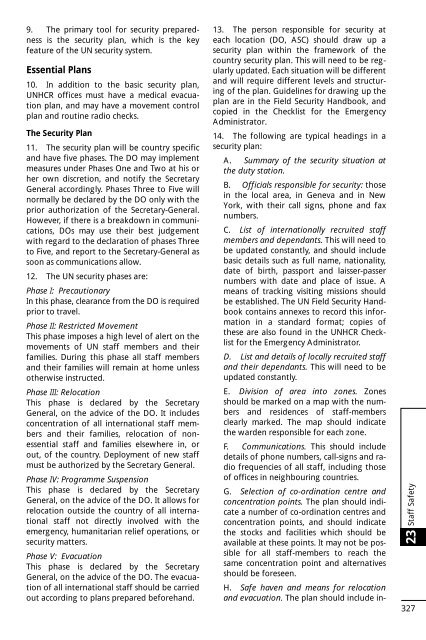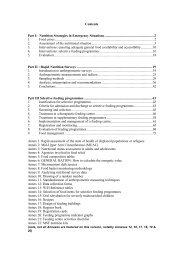UNHCR Handbook for Emergencies - UNHCR eCentre
UNHCR Handbook for Emergencies - UNHCR eCentre
UNHCR Handbook for Emergencies - UNHCR eCentre
Create successful ePaper yourself
Turn your PDF publications into a flip-book with our unique Google optimized e-Paper software.
9. The primary tool <strong>for</strong> security preparedness<br />
is the security plan, which is the key<br />
feature of the UN security system.<br />
Essential Plans<br />
10. In addition to the basic security plan,<br />
<strong>UNHCR</strong> offices must have a medical evacuation<br />
plan, and may have a movement control<br />
plan and routine radio checks.<br />
The Security Plan<br />
11. The security plan will be country specific<br />
and have five phases. The DO may implement<br />
measures under Phases One and Two at his or<br />
her own discretion, and notify the Secretary<br />
General accordingly. Phases Three to Five will<br />
normally be declared by the DO only with the<br />
prior authorization of the Secretary-General.<br />
However, if there is a breakdown in communications,<br />
DOs may use their best judgement<br />
with regard to the declaration of phases Three<br />
to Five, and report to the Secretary-General as<br />
soon as communications allow.<br />
12. The UN security phases are:<br />
Phase I: Precautionary<br />
In this phase, clearance from the DO is required<br />
prior to travel.<br />
Phase II: Restricted Movement<br />
This phase imposes a high level of alert on the<br />
movements of UN staff members and their<br />
families. During this phase all staff members<br />
and their families will remain at home unless<br />
otherwise instructed.<br />
Phase III: Relocation<br />
This phase is declared by the Secretary<br />
General, on the advice of the DO. It includes<br />
concentration of all international staff members<br />
and their families, relocation of nonessential<br />
staff and families elsewhere in, or<br />
out, of the country. Deployment of new staff<br />
must be authorized by the Secretary General.<br />
Phase IV: Programme Suspension<br />
This phase is declared by the Secretary<br />
General, on the advice of the DO. It allows <strong>for</strong><br />
relocation outside the country of all international<br />
staff not directly involved with the<br />
emergency, humanitarian relief operations, or<br />
security matters.<br />
Phase V: Evacuation<br />
This phase is declared by the Secretary<br />
General, on the advice of the DO. The evacuation<br />
of all international staff should be carried<br />
out according to plans prepared be<strong>for</strong>ehand.<br />
13. The person responsible <strong>for</strong> security at<br />
each location (DO, ASC) should draw up a<br />
security plan within the framework of the<br />
country security plan. This will need to be regularly<br />
updated. Each situation will be different<br />
and will require different levels and structuring<br />
of the plan. Guidelines <strong>for</strong> drawing up the<br />
plan are in the Field Security <strong>Handbook</strong>, and<br />
copied in the Checklist <strong>for</strong> the Emergency<br />
Administrator.<br />
14. The following are typical headings in a<br />
security plan:<br />
A. Summary of the security situation at<br />
the duty station.<br />
B. Officials responsible <strong>for</strong> security: those<br />
in the local area, in Geneva and in New<br />
York, with their call signs, phone and fax<br />
numbers.<br />
C. List of internationally recruited staff<br />
members and dependants. This will need to<br />
be updated constantly, and should include<br />
basic details such as full name, nationality,<br />
date of birth, passport and laisser-passer<br />
numbers with date and place of issue. A<br />
means of tracking visiting missions should<br />
be established. The UN Field Security <strong>Handbook</strong><br />
contains annexes to record this in<strong>for</strong>mation<br />
in a standard <strong>for</strong>mat; copies of<br />
these are also found in the <strong>UNHCR</strong> Checklist<br />
<strong>for</strong> the Emergency Administrator.<br />
D. List and details of locally recruited staff<br />
and their dependants. This will need to be<br />
updated constantly.<br />
E. Division of area into zones. Zones<br />
should be marked on a map with the numbers<br />
and residences of staff-members<br />
clearly marked. The map should indicate<br />
the warden responsible <strong>for</strong> each zone.<br />
F. Communications. This should include<br />
details of phone numbers, call-signs and radio<br />
frequencies of all staff, including those<br />
of offices in neighbouring countries.<br />
G. Selection of co-ordination centre and<br />
concentration points. The plan should indicate<br />
a number of co-ordination centres and<br />
concentration points, and should indicate<br />
the stocks and facilities which should be<br />
available at these points. It may not be possible<br />
<strong>for</strong> all staff-members to reach the<br />
same concentration point and alternatives<br />
should be <strong>for</strong>eseen.<br />
H. Safe haven and means <strong>for</strong> relocation<br />
and evacuation. The plan should include in-<br />
Staff Safety<br />
23<br />
327



